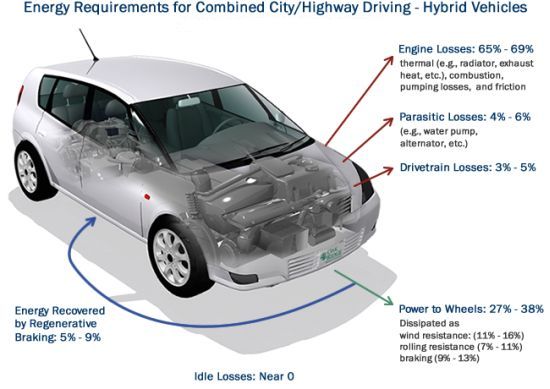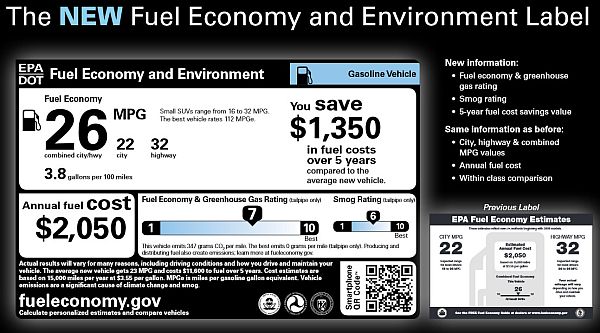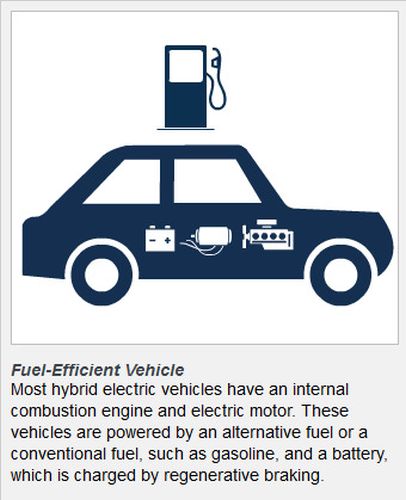If you’re looking to lower your environmental impact, buying a hybrid car may be something you’re already considering. These efficient models are more appealing than ever before, delivering impressive features and powerful options. After you purchase your vehicle, you can use auto transport services to get it home.
Preparing to buy a new car, for the first time I found myself in a position to alter the carbon footprint of a significant factor in my life. Advances in vehicle technology today, such as electric power and kinetic energy recovery systems, as well as more fuel-efficient gas models, could offer huge improvements over my 11-year-old, 27 mpg fuel economy car.

Driving 30 miles/day on average in stop-and-go traffic meant that my two largest concerns were emissions from idling and fuel economy. As a rental resident in the city, I don’t have the luxury of a reliable place to plug in my car every night. And I didn’t like the idea of having to rely on my local power grid for potentially negative-impact energy sources.
Hello, Hybrid
Within my limitations of location and lifestyle, I decided my best choice would be a hybrid (HEV). Although not in a geographic or financial position to significantly reduce my dependence on oil, I could reduce, reuse, and recycle. I especially appreciated the hybrid from the angle of energy conservation.
There’s also been a lot of negative press about these popular new car technologies. Are hidden environmental costs still a factor in production? Are battery safety and longevity legitimate concerns or a lack of understanding? Much of the information is outdated, scattered, or one-sided analyses based on profit or targeted persuasion.
Concerned with being both a responsible commuter and citizen, I decided to do my own detective work, and compile my findings as a resource for others as well.
Why the Hybrid
Hybrid Electric Vehicles (HEV) are powered by an ICE, but that engine is smaller, utilizes energy recovery systems, and shuts off when stationary, reducing idling tailpipe emissions. As Edmunds states, “The hybrid vehicle’s reason for being is to reduce gasoline use.”

On average, compact hybrid cars are more efficient than comparable conventional vehicles. They produce fewer emissions because they burn less gasoline, although the total reduction is only 10-15 percent. A lot of the hybrid’s energy is lost to engine and axle-turning (driveline) inefficiencies or used to power accessories. There are other reasons, however, HEVs are more efficient and less wasteful than conventional vehicles.
First, my favorite is that kinetic energy produced by the ICE that normally goes to waste is recaptured and used to charge the battery.
Second, a hybrid uses a smaller engine than a car of similar size. Most engines are designed for optimal use at their highest levels of power and burn gasoline comparably. A hybrid engine burns only the gas it needs for optimal average use. When the car needs extra power, it gets a boost from the battery, “electric motor drive/assist.”
Third, hybrid engines produce less heat and idling, reducing the “heat island effect,” heat-related health issues in urban areas due to human activities.
Learn more about our auto transport services.
Environmental concerns
On the heels of EV excitement, declarations of doom descended over materials and mining needed to produce the nickel-metal hydride batteries used in most EVs. Concerns ranged from the environmental impacts of nickel and copper mining to the amount of energy used to manufacture the battery and materials for production.
Most conventional ICE vehicles use lead-acid batteries. As early as 2005, the Environmental Defense compared the environmental effects of mining, manufacture, use, and disposal of lead, nickel and lithium batteries and concluded that lead batteries are worst for the environment, followed by nickel-hydride, then lithium-ion.
Mining, refining, and recycling nickel for nickel-hydride batteries all release cobalt and humans can be exposed to cobalt from producing or using these compounds. Cobalt, a cancer-causing substance, is itself now being mined more in the U.S. thanks to increasing demand for high capacity, rechargeable batteries electric vehicles and smartphones and laptops. Responsible processing, however, utilizes emissions control equipment and refining methods that capture and reduce much of this waste material before it can be released.
EV opponents point out that the electricity used to manufacture an electric car is still pulled from our relatively carbon-intensive US average grid mix. The power used to produce a vehicle is as relevant to the car’s environmental impact as its emissions. The production of lead-acid batteries most commonly used in ICE cars, however, has been shown to demand the highest energy use for production.

Both in mining and manufacturing, EVs have been shown to have no more detrimental effect on the environment than the production of conventional vehicles. Although there is a strong infrastructure in place for recycling lead-acid batteries, hybrid car manufacturers today are aggressively promoting and incentivizing customers to recycle nickel-hydride batteries, too. Many manufacturers, such as Toyota and Honda, have robust collection and recycling processes for their hybrid batteries.
Batteries not included
Another issue raised over hybrids is the possibility of increased negative exposure to humans within the vehicle itself. Much has been made of the carcinogenic properties of nickel in nickel-hydride batteries and the possibility of danger from exposure to high-voltage wiring.
Under normal use, the nickel-hydride battery itself, however, does not present a health hazard and no exposure is expected when the materials are used normally. Concerns only arise if the internal components of the battery cell are released.
Much like the misunderstanding over nickel exposure, the myth of potential safety problems from high-voltage wiring electric components is only relevant if those wires are exposed. This is unlikely to occur except during maintenance or in an accident. With today’s popularity of EVs, in each case, qualified responders and mechanics also have the ability and knowledge to avoid risk.
No need for tin foil hats
Some fears have arisen that electric vehicles could expose drivers to extremely low frequency (ELF) electromagnetic radiation (EMR) or magnetic fields that could cause cancer.
One study by the Wyoming Institute of Technology, “funded in part by part by our friends and partners at BP,” claimed that hybrid and fully-electric automobiles “pose very serious health risks to consumers” because the specific absorption rate of radiation with exposure appeared to be higher than standard safety rating (for cell phone and MRI equipment).
Other studies, however, have contradicted this claim. A 2014 research study involving ten European companies and research institutes, led by The Foundation for Scientific and Industrial Research at the Norwegian Institute of Technology, concluded that electric-powered cars and those powered by hydrogen, petrol, and diesel do not expose passengers to higher electromagnetic fields than those recommended in international standards. The highest EMF readings were found near the floor of the electric cars, close to the battery, and were still less than 20 percent of the limit.
According to Consumer Reports, there is no established threshold standard of an unhealthy dose and no scientific proof that EMF produced by electric motors is harmful to humans.

So-so savings
Unfortunately, cost savings for hybrids are not as high as pure electrics, mainly because the vehicles still use ICEs and gasoline. There has been understandable concern that more expensive maintenance might be required, from duel engine issues, evolving technology, and especially battery degeneration.
A major debate has regarded the lifetime of the battery. Nickel-hydride batteries (and lithium-ion batteries used in some EVs), all experience a gradual loss of capacity, performance, and fuel economy over time. Today, however, hybrid vehicle battery expected life is 150,000 miles, based on laboratory bench testing.
Additionally, all hybrid-specific components on the market today are covered under warranty for eight years/100,000 miles or 10 years/150,000 miles, depending on the state, although testing and in real-world conditions have shown these components to have a longer lifespan. Toyota engineers consider the nickel-hydride batteries in Prius and other Toyota hybrids to last for the life of the car.
Another important hybrid benefit is that the regenerative braking systems eliminate much of the wear on the mechanical brakes, so brake pads typically last much longer.
And while credits for conventional hybrids and most state and regional incentives for hybrid purchases were recently phased out, but there are some state incentives for vehicles which use more than one form of energy to achieve propulsion.
Off to the dealer
With current gas prices and the phasing-out of many tax credits, I learned that my higher-priced HEV will probably do little to reduce my future auto expenses. However, I’m really into it for the environmental benefits, and hybrids are still more efficient and emit fewer tailpipe pollutants. Research into fears and facts demonstrated that popular concerns over health and environmental impacts are less or equitable to that of conventional cars.
When I first learned how pure hybrids worked, the capacity to capture and reuse energy was enough to convince me I shouldn’t be driving anything else. In a world plagued by pollution, why would I contribute any more than necessary to GHG emissions? If just my foot on the brake could reduce that, even a little bit, I was sold.
If your EV interest is fueled mainly by cost savings, the average premium of a hybrid over traditional ICE vehicles isn’t proportional to the operational savings (about 6-10 years). You may want to consider how an all-electric or plug-in hybrid could meet your needs. But if you’re looking to reduce your carbon footprint without changing your lifestyle too much, the hybrid might be for you, too. For more ideas and information on environmentally conscious new car options, check out www.epa.gov/greenvehicles.
Auto transport for your new Hybrid
After you purchase your hybrid vehicle, you can rely on Montway Auto Transport to take the car to your home. This service is safe and reliable, offering an easier option for shipping your car across country.








